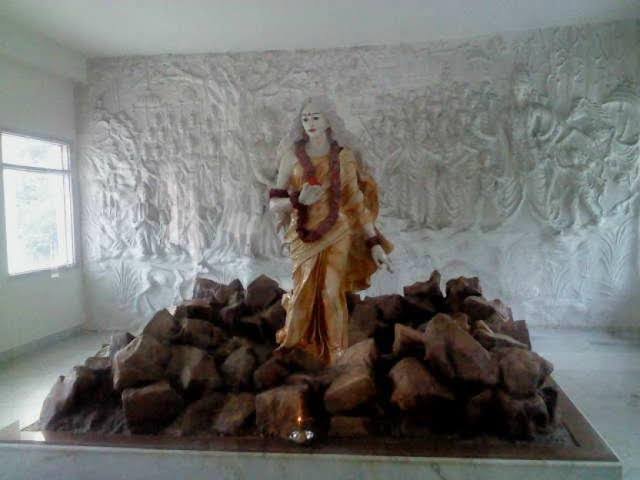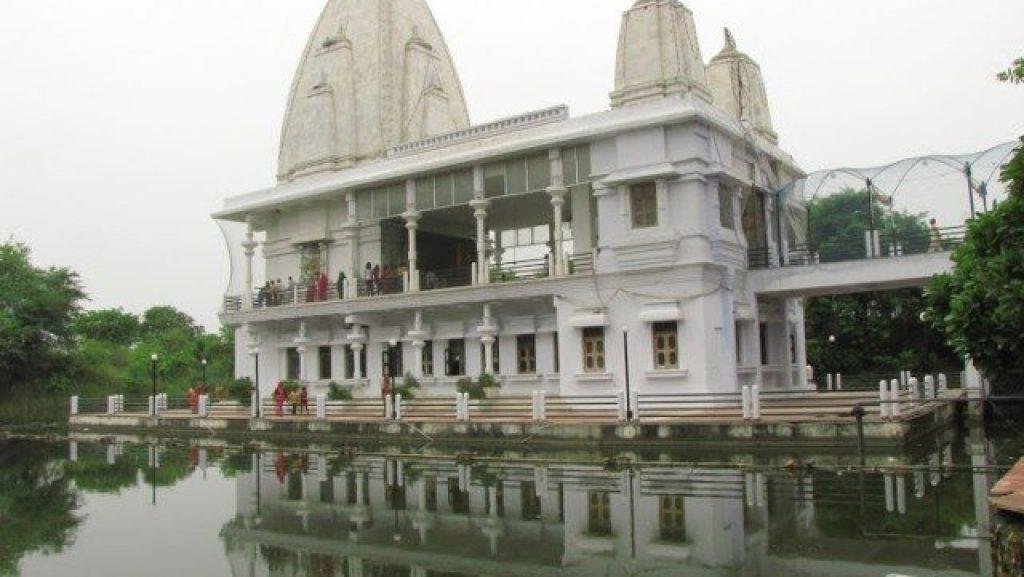Contents
Sita Samahit Sthal, located in the Bhadohi district of Uttar Pradesh, India, is a revered pilgrimage site associated with the epic Ramayana. This sacred location is believed to be where Sita, the wife of Lord Rama, went into the earth to return to her mother, Bhumi (the Earth Goddess).
This temple is situated on the banks of Ganga river and 11 km from Jangiganj Bazar in the middle of Allahabad and Varanasi. Here is the 110 feet high statue of Hanuman ji, which has the distinction of being the world’s greatest statue of the Hanuman ji.
Known for its spiritual significance and serene environment, Sita Samahit Sthal attracts devotees and tourists alike.
Architecture
Sita Samahit Sthal in Bhadohi is a masterpiece of traditional Indian architecture, harmoniously blending artistic beauty with spiritual symbolism. Its intricate designs, serene landscapes, and symbolic elements create an environment that is both aesthetically pleasing and deeply spiritual. Whether you are an architecture enthusiast or a spiritual seeker, a visit to Sita Samahit Sthal offers a rich and inspiring experience.
1. Ram Sita Temple
The centerpiece of Sita Samahit Sthal is the Ram Sita Temple, an exquisite structure showcasing the grandeur of traditional Hindu temple architecture.
- Temple Facade: The temple’s facade is adorned with intricate carvings and sculptures depicting scenes from the Ramayana. The detailed artistry brings to life the stories of Sita and Rama, creating a visual narration of their epic journey.
- Shikhara (Temple Tower): The towering shikhara, a quintessential feature of North Indian temples, rises majestically, symbolizing the temple’s spiritual aspirations. The shikhara is ornately decorated with floral motifs and religious symbols.
- Mandapa (Prayer Hall): The spacious mandapa, or prayer hall, features beautifully carved pillars and arches. The open design allows for natural light to illuminate the space, enhancing the serene ambiance.
2. Sita Kund
Adjacent to the temple is the Sita Kund, a sacred pond surrounded by artistically designed ghats (steps).
- Ghats Design: The ghats are constructed with finely cut stones, featuring steps that lead down to the water. The symmetry and precision of the stonework reflect the meticulous craftsmanship of ancient Indian architecture.
- Pavilions and Shrines: Small pavilions and shrines dot the perimeter of the pond, each adorned with carvings and statues of deities. These structures provide shaded spots for pilgrims to rest and meditate.
3. Gardens and Pathways
The lush gardens and pathways of Sita Samahit Sthal are designed to enhance the spiritual experience of visitors.
- Landscaped Gardens: The gardens are meticulously landscaped, with flowering plants, manicured lawns, and shaded walkways. The use of local flora not only beautifies the space but also creates a tranquil environment for contemplation.
- Pathways: The pathways are paved with natural stones, featuring decorative patterns that guide visitors through the site. Benches and resting spots are strategically placed along the paths, offering places for relaxation and reflection.
Symbolic Elements
The architecture of Sita Samahit Sthal incorporates numerous symbolic elements that reflect its spiritual significance.
- Lotus Motifs: The lotus, a symbol of purity and enlightenment, is a recurring motif in the temple’s carvings and decorations. This symbolizes Sita’s divine purity and connection to the Earth.
- Depictions of Ramayana: Sculptures and frescoes depicting various episodes from the Ramayana serve as both decorative and didactic elements, teaching visitors about the values and virtues exemplified by Sita and Rama.
Legend / Local stories
The site’s historical and mythological roots are deeply intertwined with the Ramayana. According to legend, after proving her purity in the trial by fire, Sita chose this spot to end her earthly life and return to her divine origins. This poignant story enhances the site’s importance for followers of Hinduism and those interested in India’s rich cultural heritage.
Festivals and Events
The site is particularly vibrant during Hindu festivals such as:
- Ram Navami: Celebrating the birth of Lord Rama, this festival attracts large crowds who participate in special prayers and ceremonies.
- Sita Navami: Marking the birth of Sita, this event sees a surge in pilgrim activity, with various cultural and religious programs.
Photo Gallery




How to Reach:
Sita Samahit Sthal is accessible through various modes of transportation. Here is a comprehensive guide on how to reach this sacred destination.
By Air
The nearest airport to Sita Samahit Sthal is Lal Bahadur Shastri International Airport in Varanasi.
- Distance: Approximately 70 kilometers from Bhadohi.
- Transportation from Airport: Visitors can hire a taxi or take a bus from the airport to Bhadohi. Private car rentals and app-based cab services are also available for a more comfortable journey.
By Train
Bhadohi Railway Station is well-connected to major cities in India, making it a convenient option for reaching Sita Samahit Sthal.
- Nearest Railway Station: Bhadohi Railway Station (Code: BOY).
- Distance: The railway station is about 10 kilometers from Sita Samahit Sthal.
- Transportation from Railway Station: Auto-rickshaws, cycle-rickshaws, and local taxis are readily available outside the railway station to take you directly to the temple.
By Road
Bhadohi is well-connected by road to various cities and towns in Uttar Pradesh and neighboring states.
- By Bus: Regular bus services are available from major cities like Varanasi, Allahabad (Prayagraj), and Lucknow. State-run buses, as well as private buses, ply these routes frequently.
- By Car: For those who prefer to drive, Bhadohi is accessible via well-maintained highways. The drive offers scenic views of rural Uttar Pradesh.
Local Transportation
Once you arrive in Bhadohi, several local transportation options can help you reach Sita Samahit Sthal comfortably.
- Auto-rickshaws and Cycle-rickshaws: These are commonly used for short distances and are economical.
- Taxis and Car Rentals: For a more comfortable and convenient option, taxis and private car rentals are available.
- Buses: Local buses also operate within the city, connecting various points, including Sita Samahit Sthal.
Directions from Major Cities
1. From Varanasi
- Distance: Approximately 60 kilometers.
- Route: Take the Varanasi-Lucknow Road (NH31) and follow the signs to Bhadohi. The journey takes around 1.5 to 2 hours by car.
2. From Allahabad (Prayagraj)
- Distance: Approximately 80 kilometers.
- Route: Follow the NH19 and then take the Bhadohi-Mirzapur Road. The drive usually takes around 2 hours.
3. From Lucknow
- Distance: Approximately 240 kilometers.
- Route: Take the Lucknow-Allahabad Road (NH30) towards Prayagraj, then follow the NH19 and Bhadohi-Mirzapur Road to Bhadohi. The journey takes around 5 to 6 hours by car.
Plan your journey accordingly to ensure a comfortable and spiritually enriching visit to this sacred site.












